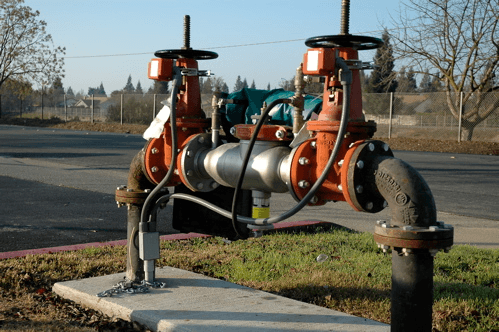Backflow Preventers Information
 Backflow preventers are assemblies with two check valves and two shut-off valves that prevent reverses in process flow. They may also include test cocks for each chamber within the assembly. Backflow preventers have a variety of applications. For example, they are used to prevent boiler water, which may contain anti-freeze, from contaminating water supplies.
Backflow preventers are assemblies with two check valves and two shut-off valves that prevent reverses in process flow. They may also include test cocks for each chamber within the assembly. Backflow preventers have a variety of applications. For example, they are used to prevent boiler water, which may contain anti-freeze, from contaminating water supplies.
Types of Backflow Preventers
Backflow preventers use several types of check valves.
Swing check valves have a closure element that is pushed aside by the flow, but that swings back into the close position when the flow is reversed.
Double disc, or wafer check, valves are comprised of two half-circle discs that fold together when the flow is positive and retract when the flow is reversed.
Lift check valves have a free-floating closure element consisting of a seat ring and a piston, or poppet, that actuates horizontally or perpendicularly to the flow.
Silent, or center guide, checks are similar to lift check valves, but have a center guide extending from inlet to outlet ports.
Ball check and cone check valves use a free-floating or spring-loaded ball or cone, respectively, to prevent backflow.
Materials
The valves in backflow preventers are often made of metal. Brass provides good strength and conductivity, and copper is one of the best conductors of heat and electricity. Bronze is not suitable for heavily loaded applications, but is useful where lubrication is inconvenient. Cast iron is composed primarily of iron, but also has important trace amounts of carbon and silicon. Steel, a commercial iron that contains carbon as an essential alloying constituent, has less carbon than cast iron, and is malleable. Stainless steel is chemical and corrosion resistant and is rated for high pressures. Ductile iron retains cast iron’s machinability and corrosion-resistance while incorporating significant casting refinements.
The valves in backflow preventers may also be made of plastic. Polyvinyl chloride (PVC) is a widely used material with good flexibility and non-toxic qualities. Polypropylene (PP) is similar to PVC, but can be used in exposed applications because of its resistance to ultraviolet (UV) rays, weathering, and ozone. Chlorinated polyvinyl chloride (CPVC), a higher grade of plastic, is commonly used in sprinkler piping and for distributing hot and cold water. Polyvinylidene fluoride (PVDF), a melt processable fluoropolymer, provides good weather resistance and excellent chemical resistance, but does not perform well at elevated temperatures. Polytetrafluoroethylene (PTFE) is an insoluble compound that has a high degree of chemical resistance and a low coefficient of friction.
Standards
The check valves in backflow preventers meet dimensional, material, pressure, and flow standards established by various organizations. These standards include requirements from the American Petroleum Institute (API), the Manufacturers Standardization Society (MSS), the American Society of Mechanical Engineers (ASME), and Underwriters Laboratories Inc. (UL). Some check valves in backflow preventers also meet FED SPEC WW-V-35C specifications.
Related Information
CR4 Community—Connecting Utility Lines to Process Lines
CR4 Community—Water Pipe Pitting
Image credit:
Verifiedbackflow / CC BY-SA 3.0
- blowout preventer
- rpz backflow preventer
- air backflow preventers
- double check valve backflow preventer
- 2 PVC backflow preventers
- 4 PVC backflow preventers
- 6 PVC backflow preventers
- 8 hersey backflow preventers
- compressed air backflow preventers
- cooling tower backflow preventers
- dishwasher backflow preventers
- dishwasher inline backflow preventers
- fire sprinkler backflow preventers
- gas backflow preventers
- glycol sprinkler system backflow preventers
- high pressure backflow preventers
- hydrant backflow preventers
- ice maker backflow preventers
- in line gas backflow preventers
- natural gas backflow preventers
- outdoor faucet backflow preventers
- plastic backflow preventers
- sewer gas backflow preventers
- steam boiler backflow preventers
- storm drain backflow preventers
- water backflow preventers
- water meter backflow preventers
